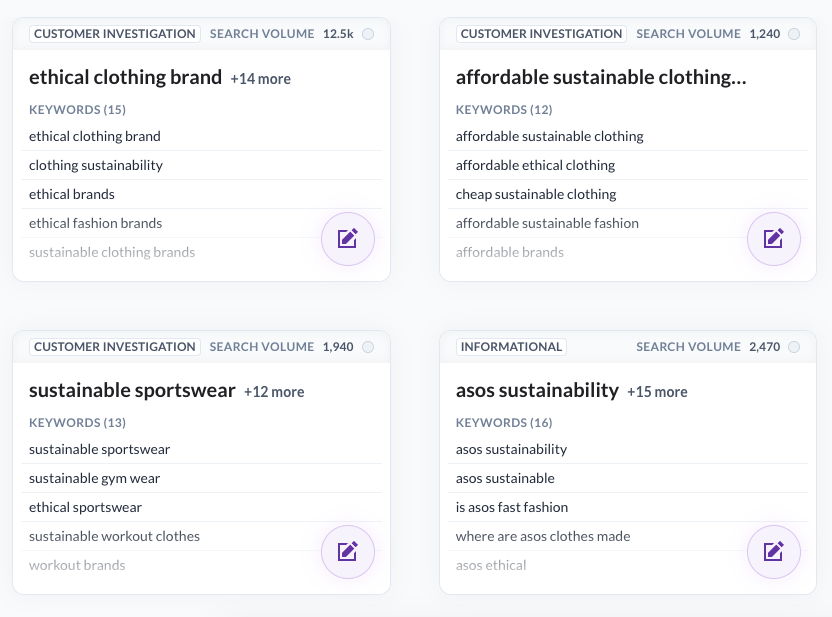In this post, I will show you exactly how to write a blog in less than 30 minutes.
In fact:
These are the exact techniques I used to write 100+ blog posts which now generate more than 200,000 monthly website visits.
Let’s dive right in.
The Power of Blogging and Why It’s Important
If you’re a business owner, it’s likely that you want to:
- Increase your website traffic
- Attract new customers
- Generate customer loyalty
- Be the expert in your niche
And herein lies the power of a blog.
A well-written, informative blog aligned with your business goals and customer pain points is hugely valuable to your business.
Not only does a blog help you to generate, nurture and convert traffic, but it also helps keep your existing customers engaged, increases demand for your products, and places you as the leader in your field.
If you craft great content, they can even generate lots of natural organic backlinks without you having to lift a finger. Not bad, huh.
What’s more, unlike paid ads, blogs will continue to offer value long after you’ve hit publish.
Not convinced? Consider these stats:
- A business that blogs, on average, receives 55% more website visitors than a business that doesn’t.
- Companies that blog get a whopping 97% more links to their website.
- 30% of customers learn about brands via ads, as opposed to 70% through blogs.
But be warned, blogging is not for the faint of heart. It requires consistency, a strategy and an overall understanding of your customer’s pain points. The content needs to be helpful, engaging and relevant to your audience.
How to Generate Blog Content Ideas
If you are going to write content regularly, it’s a good idea to write down a content pipeline – all the themes you want to explore. You can keep these in a notebook or Excel sheet for inspiration. Copy and paste links of similar blogs or blog posts that sparked the idea - this is your 'content pipeline'.
When you’ve got a spare half an hour set aside to write your blog, all you need is a great headline to get you going. If you’ve created a content pipeline, it’s super easy to pick one and get started.
Good sources of inspiration can include:
Google Autosuggest Results
A good blog aims to answer your customers’ questions, so the first step is to find out what your customers want to know.
Luckily, you can easily find out what your audience is searching for using Google’s autosuggest results.
Open Google in incognito, search for a topic that you are considering writing about and Google will suggest similar phrases that people search for. Use these results for inspiration for your blog title.

Conduct Keyword Research
Use SurferSEO to find out what your target audience is searching for. For example, if you’re interested in “sustainable clothing brands,” plug it in Surfer’s content planner to find clusters of keywords for potential topic ideas.

With just one topic idea, e.g., sustainable clothing line, SurferSEO suggests 119 clusters of keywords. Take “sustainable sportswear” as an example; it has a potential search volume of 1,940.
A quick look on Google and you can easily find ideas for content titles related to this topic:

Easy. You now have a killer idea for the topic “X sustainable activewear brands.”
Do you get the idea? Transform the keywords into clickable, irresistible blog post titles.
Use Also Asked
Like Answer the Public, alsoasked.com is free (hooray!), albeit a little slow at the moment but the team who have built it are constantly improving it. Nevertheless, it’s a helpful tool to understand your customers’ questions and dig deeper into a topic and ensure you answer all of the questions people ask.
It will fire out questions and if they make sense to your content, you can include them in your post, along with your answers.
How to Craft the Post and Break It Down
Now we come to the critical question: How to write a blog post? This process has worked for many content writers, but it’s not set in stone. Find out what works for you and refine the blogging process over time.
Let’s look at how to craft a post and break it down from start to finish.
Breaking It Down Step-by-Step: Writing the Blog Post

The First Twenty Minutes
Let’s break down the first twenty minutes of writing. This will be the most challenging part of the blog writing process to get done.
The First Two Minutes
Have you got your topic and angle? Use the suggestions above to decide on your topic quickly. Bonus points if you’ve already built up a content pipeline of topics to choose from. If you want to achieve writing a blog post in 30 minutes or less, having a topic pipeline is essential.
But don’t stop there. Once you’ve decided on the topic, you need to create a click-worthy headline.
Did you know that having a colon in a blog headline increases your click-through by nearly 10%? While only between 6-8 words in your headline can improve CTR by more than 20%.
It’s a fact. An uninspiring headline can kill a blog in its tracks, so take the time to make sure it’s engaging and speaks to your target audience.
Three Minutes In
Now you can start writing and working on the things that make you unique. Do a cursory Google search if you have to. You want to establish if the topic has already been covered before, and if it has, decide how you will change the angle to make your blog post unique and engaging.
Not every idea has to be original, but it does have to add value to the reader. It would help if you also decided the tone you want to take.
How many words do you want to write on average in your posts, and in what format? What makes your blog post different? Be clear on what you want to say before attempting to say it.
Five to Eight Minutes In
During the next step, you set the direction of the blog and your outline. Generally, you should start with an intro, a few points, and a strong reiteration of what you’ve said already.
Start jotting down bullet points or craft a sentence or two in each paragraph. It might be helpful to think of the various subheaders you’d like to use.
If you don’t like typing or find yourself making too many mistakes, why not try voice dictation? It’s less intimidating than a blank page and is a great way to bring your conversational style to life.
Minute Eight to Twenty
Use the next twelve minutes to flesh out your sub-headings with content. If you get stuck or find yourself struggling to express yourself, try using quotations from other writers. Research as you go, adding statistics and quotes to emphasize your point.
If you find yourself battling to formulate the right idea, it’s OK to set it again. Try another topic, or come back to it later.
If an idea isn’t ready yet, add it to your pipeline and come back when inspiration strikes.
The Final Ten Minutes
You are almost there. You’ve got your introductory blog post planned, and you’ve written the bulk of the post down. Now you need to spend ten minutes putting on the finishing touches. Pat yourself on the back!
Twenty-Minutes to Twenty-Two Minutes
Write your introduction. Once you’ve fleshed out your sub-headings, you can add context to your intro. It’s OK to write it down before fleshing out the piece too! Whatever works for you.
Your introduction will set the stage and give readers an idea of what they can expect from the piece, making sure to hook them with good content.
Twenty-Two to Twenty-Four Minutes
Next, take two minutes to draft your call to action. What would you like them to do after reading this post?
Calls to action can include:
- “Let me know what you think of this article by leaving a comment below.”
- “If you love this (item) as much as I do, visit our store by clicking on this link.”
- “Read more about this topic by visiting (link).”
- “Download this eBook for more advice.”
- “If you like this article, please share it on your social media pages.”
- “Bookmark this article so you can refer back to it when you need to.”
Your call to action has to be concise and clear.
Brian Dean is the king of engagement, with many of his blogs getting hundreds, if not thousands, of comments. By asking simple questions, he engages his readers, like this:

Twenty-Four to Twenty-Six Minutes In
The following two minutes should be spent sourcing images. You can use premium photo sites like Deposit Photos to get the best photos. I'd recommend signing up to a small monthly subscription instead of paying for individual photos. If you need to, credit the creator.
Your images should enhance your message and stand out, but they are also vital for SEO. If you use your own photos, you may want to add a logo and watermark to prevent others from repurposing them.
Depending on the type of content and your audience, screenshots with annotations and arrows may offer the most value. Screenshots are a great way to create an actionable blog that your reader can implement.
Twenty-Six Minutes to Twenty-Eight Minutes In
Start editing. Re-read your post. Edit your subheaders or more paragraphs around for clarity. Check for spelling and grammatical errors. It sometimes helps to read the post out loud.
If you aren’t good at spelling or just need a fresh set of eyes, you may want to put your work through Grammarly (highly recommended) or WordTune.

Depending on your audience, it can be helpful to use Hemingway to tell you at what Grade Level you are writing. Unless you are writing on a highly technical level, you want to aim for Grade 4-6 level writing.
It’s not that your audience won’t understand you, but rather that your audience might simply scan your blog post. You want them to get the gist of it, even if they are reading in a hurry. Keeping the language simple will help them understand it.

It’s also a good idea to run a Grammarly or Copyscape check for plagiarism. Plagiarism is never a good idea. You probably won't run into legal issues for stealing a couple of lines, but your performance in search will be limited as they’ll think you are copying someone else’s content. Don’t jeopardise your discoverability by stealing content. Never copy the content of another website, write it in your own words.
The Final Two Minutes
Use your final minutes to write a 140-160 character meta description that describes your blog. It has to entice click-throughs from search engines, so try to phrase it like you would a call to action. For example:
“We all want to dress our best. Read this blog to find out how you can revamp your wardrobe for summer.”
“Want to improve your iPhone photography skills? Here are five ways you can snap better pictures in 2021.”
Run it through a tool like Meta Tags to ensure it’s the right length:

Bonus tip: include emojis. They help to increase click-through rates. Larry Kim saw an amazing 300% increase in CTR by using Emojis in Ad copy.
How to Promote the Post Once Complete
Now that you’ve written your blog post, you want to get it out there! You can mention influencers that have inspired you to post or whose ideas you are building on and tag them in the post, asking them to share.
Alternatively, you can publish to a third-party blog tool like Medium for broader reach. (Add a canonical tag back to your blog post to avoid self-cannibalising your blog!).
If you are serious about your blog and want mass uptake, promote the blog on social media by posting the link and putting a tiny budget behind advertising it, targeting your ideal readership.
Don’t forget to embed social share buttons and call to action in all your posts!
Once this is done, reach out to influencers in your niche and ask if they'd be happy taking a read and possibly sharing it with their audience. Quick tip - if you mention influencers in your blog post, they are more likely to share it.
Summary
Do you know how long this blog post took to write? Thirty minutes! Now that you know how to write yours, you can start producing high-level, engaging content for your blog.
Have fun with your blog! Pick topics that you are passionate about, don’t clone anybody else.
I look forward to reading your blog soon! Add a link to your blog in the comments below when it’s ready.






